Abstract
Substantial data have been generated during the last 5 years in experimental systems and human populations which shed light on the potential usefulness of biological markers in human cancer risk assessment. Following a brief review of overall progress to date in the biomonitoring of human populations, this paper turns to the growing body of data regarding carcinogen-DNA and protein adducts as illustrative markers of biologically effective dose of carcinogens. The data base illustrates considerable human inter-individual variation in binding and the presence of significant "background" levels of adducts--both of which support the absence of human population thresholds for exposure to carcinogens. The contribution of adduct data to our understanding of the shape of low dose-response curve and the reliability of inter-species extrapolation, as well as the relevance of adducts to cancer risk, are also discussed. Even though adducts can now be useful in hazard identification or qualitative risk assessment, more research is needed before they can serve as quantitative predictors of human cancer risk.
Full text
PDF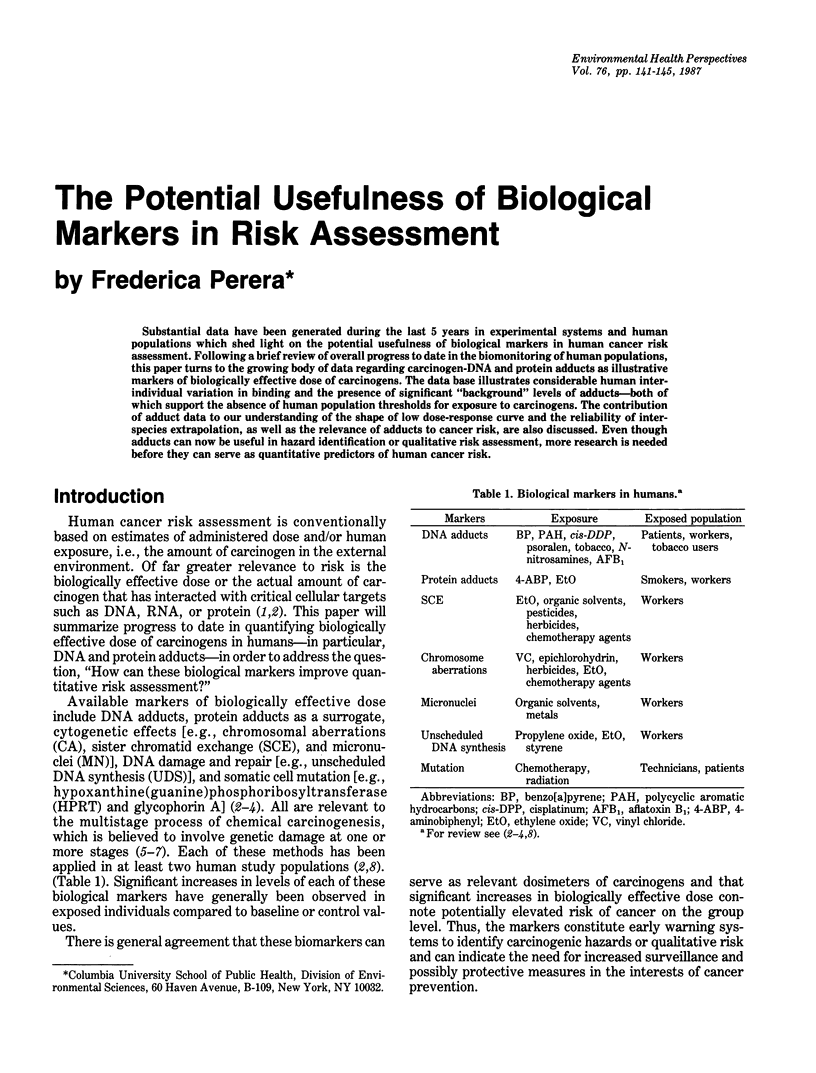
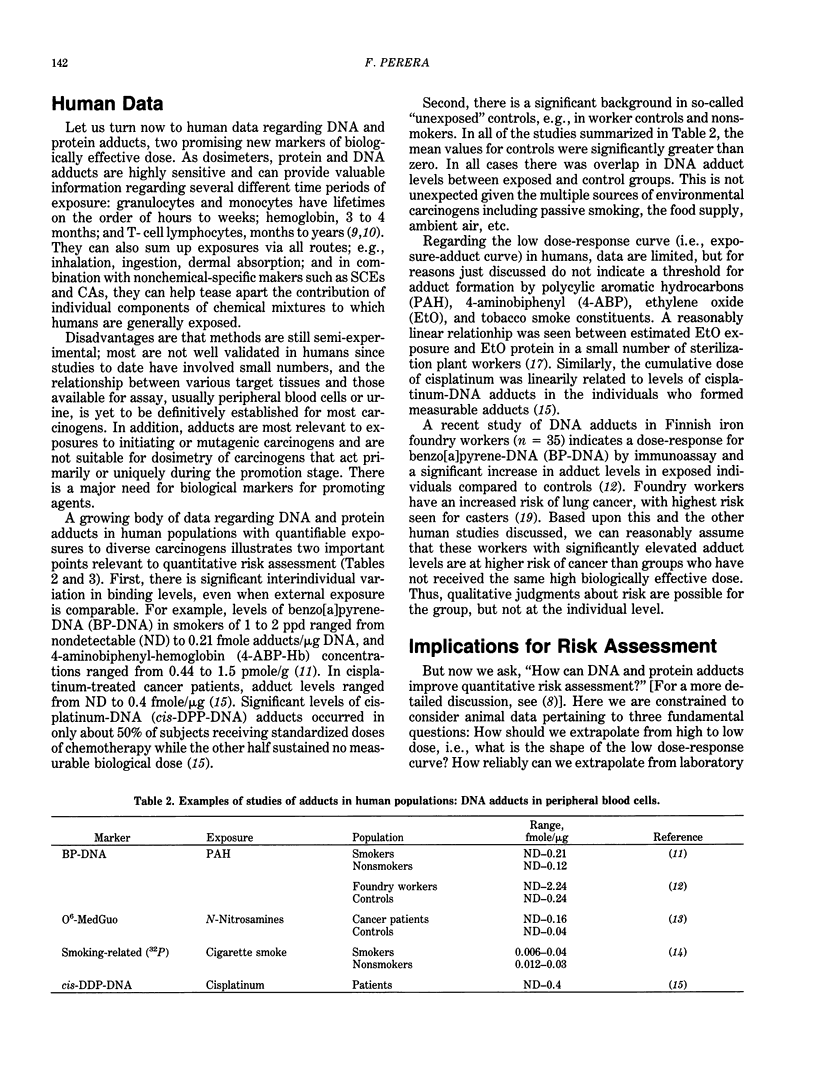
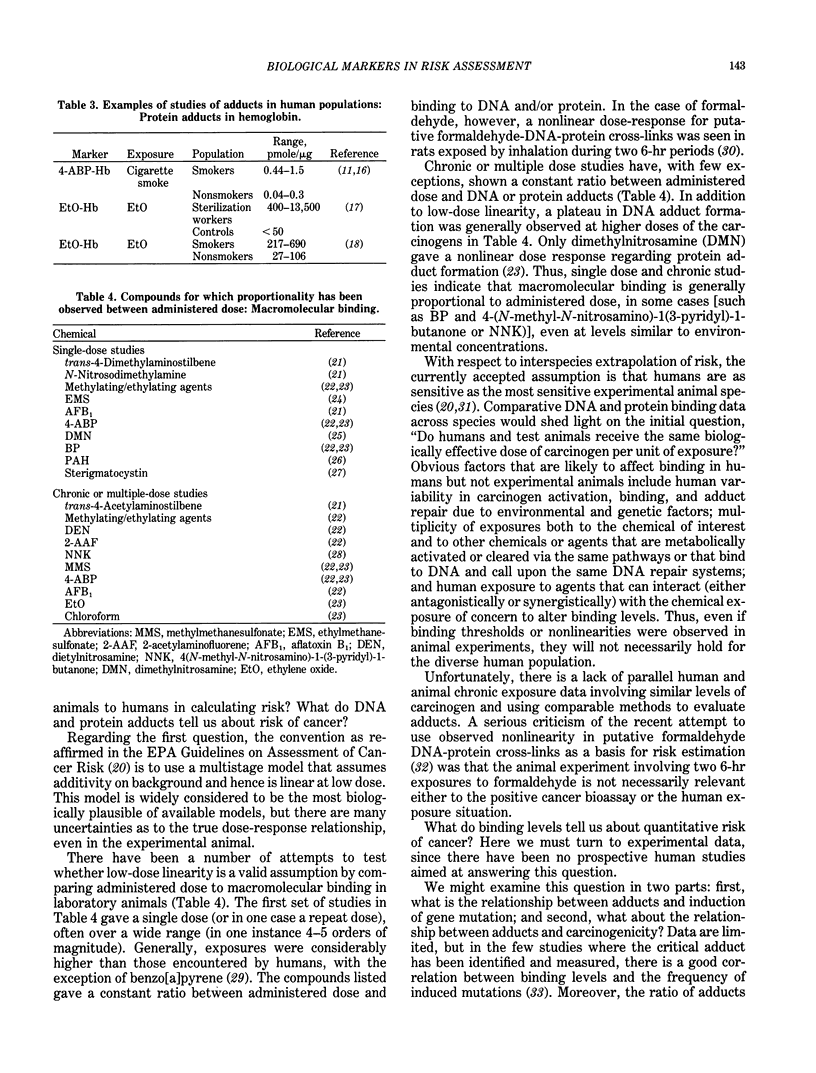
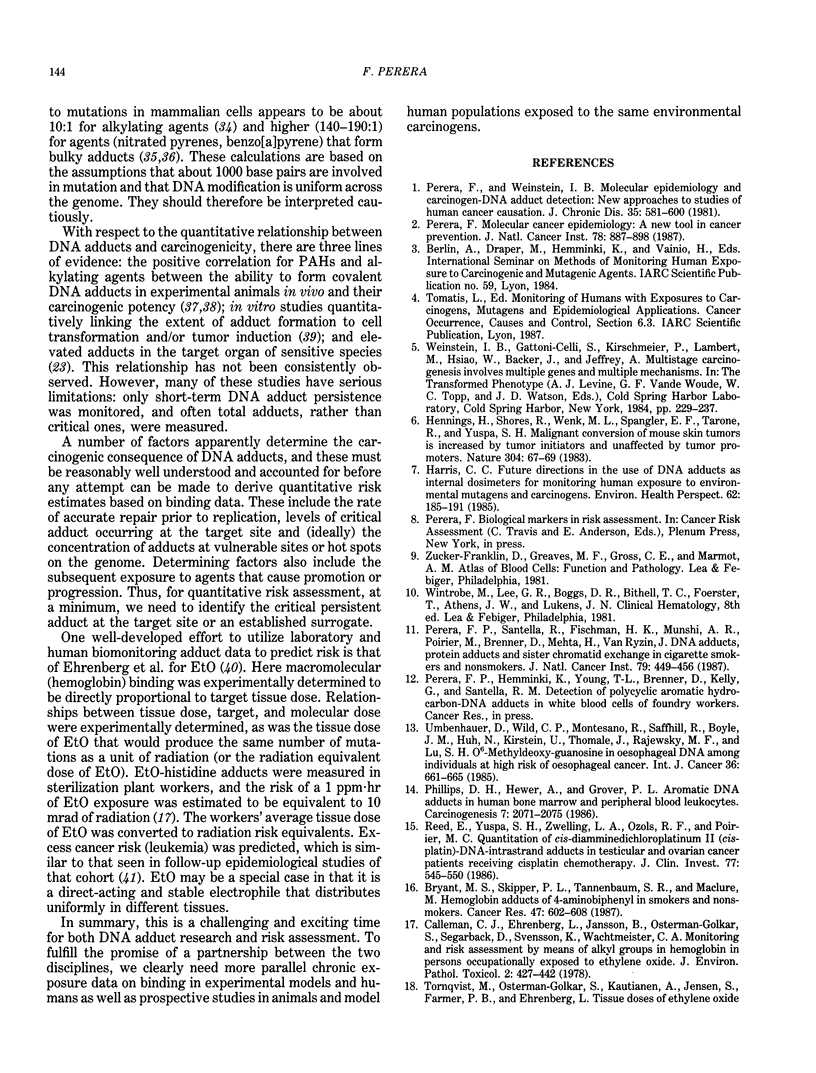
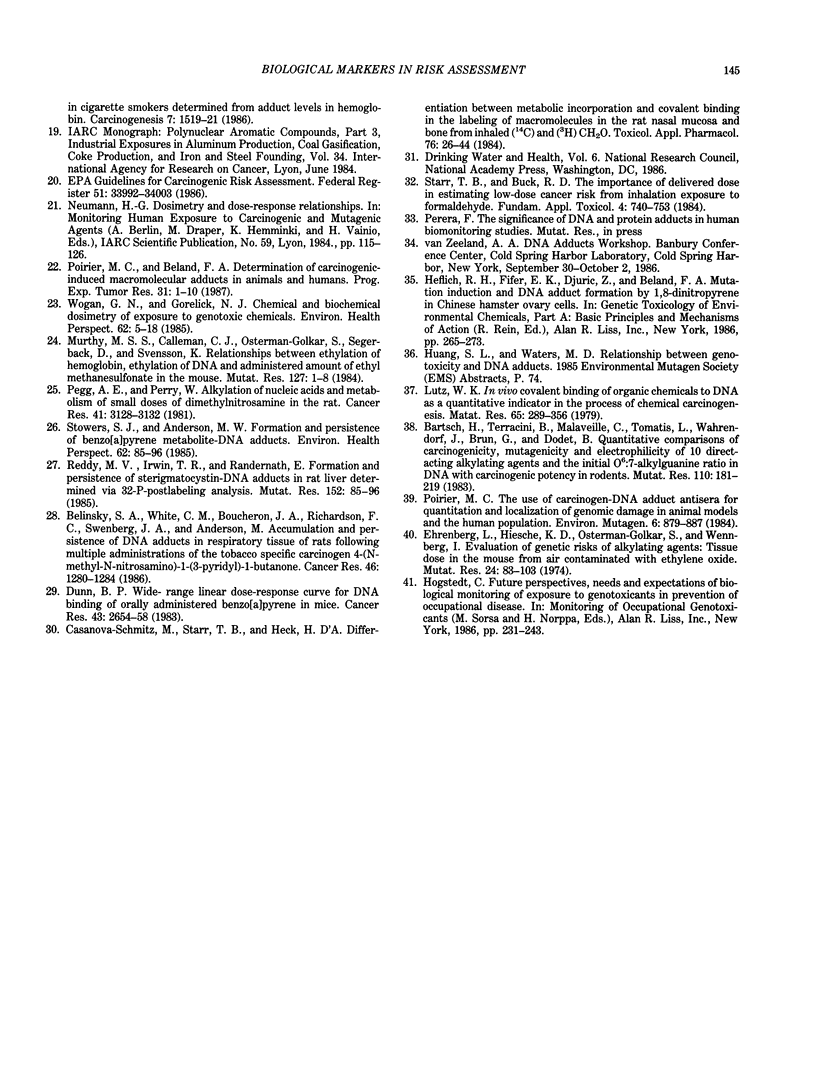
Selected References
These references are in PubMed. This may not be the complete list of references from this article.
- Bartsch H., Terracini B., Malaveille C., Tomatis L., Wahrendorf J., Brun G., Dodet B. Quantitative comparison of carcinogenicity, mutagenicity and electrophilicity of 10 direct-acting alkylating agents and of the initial O6:7-alkylguanine ratio in DNA with carcinogenic potency in rodents. Mutat Res. 1983 Aug;110(2):181–219. doi: 10.1016/0027-5107(83)90140-9. [DOI] [PubMed] [Google Scholar]
- Belinsky S. A., White C. M., Boucheron J. A., Richardson F. C., Swenberg J. A., Anderson M. Accumulation and persistence of DNA adducts in respiratory tissue of rats following multiple administrations of the tobacco specific carcinogen 4-(N-methyl-N-nitrosamino)-1-(3-pyridyl)-1-butanone. Cancer Res. 1986 Mar;46(3):1280–1284. [PubMed] [Google Scholar]
- Bryant M. S., Skipper P. L., Tannenbaum S. R., Maclure M. Hemoglobin adducts of 4-aminobiphenyl in smokers and nonsmokers. Cancer Res. 1987 Jan 15;47(2):602–608. [PubMed] [Google Scholar]
- Calleman C. J., Ehrenberg L., Jansson B., Osterman-Golkar S., Segerbäck D., Svensson K., Wachtmeister C. A. Monitoring and risk assessment by means of alkyl groups in hemoglobin in persons occupationally exposed to ethylene oxide. J Environ Pathol Toxicol. 1978 Nov-Dec;2(2):427–442. [PubMed] [Google Scholar]
- Casanova-Schmitz M., Starr T. B., Heck H. D. Differentiation between metabolic incorporation and covalent binding in the labeling of macromolecules in the rat nasal mucosa and bone marrow by inhaled [14C]- and [3H]formaldehyde. Toxicol Appl Pharmacol. 1984 Oct;76(1):26–44. doi: 10.1016/0041-008x(84)90026-7. [DOI] [PubMed] [Google Scholar]
- Dunn B. P. Wide-range linear dose-response curve for DNA binding of orally administered benzo(a)pyrene in mice. Cancer Res. 1983 Jun;43(6):2654–2658. [PubMed] [Google Scholar]
- Ehrenberg L., Hiesche K. D., Osterman-Golkar S., Wenneberg I. Evaluation of genetic risks of alkylating agents: tissue doses in the mouse from air contaminated with ethylene oxide. Mutat Res. 1974 Aug;24(2):83–103. doi: 10.1016/0027-5107(74)90123-7. [DOI] [PubMed] [Google Scholar]
- Harris C. C. Future directions in the use of DNA adducts as internal dosimeters for monitoring human exposure to environmental mutagens and carcinogens. Environ Health Perspect. 1985 Oct;62:185–191. doi: 10.1289/ehp.8562185. [DOI] [PMC free article] [PubMed] [Google Scholar]
- Hennings H., Shores R., Wenk M. L., Spangler E. F., Tarone R., Yuspa S. H. Malignant conversion of mouse skin tumours is increased by tumour initiators and unaffected by tumour promoters. Nature. 1983 Jul 7;304(5921):67–69. doi: 10.1038/304067a0. [DOI] [PubMed] [Google Scholar]
- Hogstedt C. Future perspectives, needs and expectations of biological monitoring of exposure to genotoxicants in prevention of occupational disease. Prog Clin Biol Res. 1986;207:231–243. [PubMed] [Google Scholar]
- Lutz W. K. In vivo covalent binding of organic chemicals to DNA as a quantitative indicator in the process of chemical carcinogenesis. Mutat Res. 1979 Dec;65(4):289–356. doi: 10.1016/0165-1110(79)90006-x. [DOI] [PubMed] [Google Scholar]
- Murthy M. S., Calleman C. J., Osterman-Golkar S., Segerbäck D., Svensson K. Relationships between ethylation of hemoglobin, ethylation of DNA and administered amount of ethyl methanesulfonate in the mouse. Mutat Res. 1984 Jun;127(1):1–8. doi: 10.1016/0027-5107(84)90133-7. [DOI] [PubMed] [Google Scholar]
- Pegg A. E., Perry W. Alkylation of nucleic acids and metabolism of small doses of dimethylnitrosamine in the rat. Cancer Res. 1981 Aug;41(8):3128–3132. [PubMed] [Google Scholar]
- Perera F. P. Molecular cancer epidemiology: a new tool in cancer prevention. J Natl Cancer Inst. 1987 May;78(5):887–898. [PubMed] [Google Scholar]
- Perera F. P., Santella R. M., Brenner D., Poirier M. C., Munshi A. A., Fischman H. K., Van Ryzin J. DNA adducts, protein adducts, and sister chromatid exchange in cigarette smokers and nonsmokers. J Natl Cancer Inst. 1987 Sep;79(3):449–456. [PubMed] [Google Scholar]
- Perera F. P., Weinstein I. B. Molecular epidemiology and carcinogen-DNA adduct detection: new approaches to studies of human cancer causation. J Chronic Dis. 1982;35(7):581–600. doi: 10.1016/0021-9681(82)90078-9. [DOI] [PubMed] [Google Scholar]
- Phillips D. H., Hewer A., Grover P. L. Aromatic DNA adducts in human bone marrow and peripheral blood leukocytes. Carcinogenesis. 1986 Dec;7(12):2071–2075. doi: 10.1093/carcin/7.12.2071. [DOI] [PubMed] [Google Scholar]
- Poirier M. C., Beland F. A. Determination of carcinogen-induced macromolecular adducts in animals and humans. Prog Exp Tumor Res. 1987;31:1–10. doi: 10.1159/000413897. [DOI] [PubMed] [Google Scholar]
- Poirier M. C. The use of carcinogen-DNA adduct antisera for quantitation and localization of genomic damage in animal models and the human population. Environ Mutagen. 1984;6(6):879–887. doi: 10.1002/em.2860060615. [DOI] [PubMed] [Google Scholar]
- Reddy M. V., Irvin T. R., Randerath K. Formation and persistence of sterigmatocystin--DNA adducts in rat liver determined via 32P-postlabeling analysis. Mutat Res. 1985 Oct;152(1):85–96. [PubMed] [Google Scholar]
- Reed E., Yuspa S. H., Zwelling L. A., Ozols R. F., Poirier M. C. Quantitation of cis-diamminedichloroplatinum II (cisplatin)-DNA-intrastrand adducts in testicular and ovarian cancer patients receiving cisplatin chemotherapy. J Clin Invest. 1986 Feb;77(2):545–550. doi: 10.1172/JCI112335. [DOI] [PMC free article] [PubMed] [Google Scholar]
- Starr T. B., Buck R. D. The importance of delivered dose in estimating low-dose cancer risk from inhalation exposure to formaldehyde. Fundam Appl Toxicol. 1984 Oct;4(5):740–753. doi: 10.1016/0272-0590(84)90095-2. [DOI] [PubMed] [Google Scholar]
- Umbenhauer D., Wild C. P., Montesano R., Saffhill R., Boyle J. M., Huh N., Kirstein U., Thomale J., Rajewsky M. F., Lu S. H. O(6)-methyldeoxyguanosine in oesophageal DNA among individuals at high risk of oesophageal cancer. Int J Cancer. 1985 Dec 15;36(6):661–665. doi: 10.1002/ijc.2910360607. [DOI] [PubMed] [Google Scholar]
- Wogan G. N., Gorelick N. J. Chemical and biochemical dosimetry of exposure to genotoxic chemicals. Environ Health Perspect. 1985 Oct;62:5–18. doi: 10.1289/ehp.85625. [DOI] [PMC free article] [PubMed] [Google Scholar]


